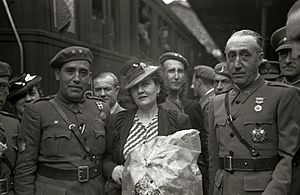Mariano Gómez-Zamalloa y Quirce facts for kids
Quick facts for kids
Mariano Gómez-Zamalloa y Quirce
|
|
|---|---|

Gómez-Zamalloa as an officer of the Blue Division, 1941–43
|
|
| Birth name | Mariano Gómez-Zamalloa y Quirce |
| Born | March 26, 1897 A Coruña |
| Died | September 4, 1973 (aged 76) Madrid |
| Allegiance | (1909–1931) (1931–1936) (1936–1941, 1942–1950) (1941–1942) |
| Service/ |
|
| Years of service | 1909–41, 1942–68 (Spain) 1941–42 (Germany) |
| Rank | General |
| Unit | Regulares Blue Division |
| Commands held | Armoured Division No. 1 "Brunete" |
| Battles/wars | Rif War Spanish Civil War World War II Ifni War |
| Awards | |
| Other work | Governor-General of Spanish West Africa (1957–1958) |
Mariano Gómez-Zamalloa y Quirce (born March 26, 1897, in A Coruña – died September 4, 1973, in Madrid) was a Spanish military officer and a leader in Spanish colonies. He had a long career in the army, fighting in several wars and later serving as a governor.
Contents
A Life in the Military
Early Military Career
Mariano came from a family of soldiers. He started his military training at the Toledo Infantry Academy in 1909 when he was just 12 years old. In 1925, he became a lieutenant. He took part in the Rif War as an officer with the "Ceuta" Group Nº 3 of the Regulares, which were special army units.
In July 1936, when the Spanish Civil War began, he was a captain in the same Regulares regiment in Ceuta. He joined the Nationalist side. He led his unit across the Strait of Gibraltar on a destroyer ship called Churruca. They landed in Cádiz and helped the Nationalist forces take control of the city.
Fighting in the Spanish Civil War
Mariano was promoted to commander. He moved to Jerez de la Frontera, where he led groups of right-wing supporters and landowners. With these groups, he fought in different military operations in the provinces of Cádiz and Seville. His forces captured towns like Arcos de la Frontera and Olvera.
Later, his unit helped advance towards Madrid, the capital city. They marched through Extremadura and the Tagus River valley. During the intense fighting for Madrid, he fought in areas like Casa de Campo, Carabanchel, and Ciempozuelos. He also took part in the Battle of Jarama. For his bravery at Jarama, he received the Military Medal and the Laureate Cross of Saint Ferdinand in 1940. In the same year, he became a lieutenant colonel.
Joining the Blue Division in World War II
From July 1941, Mariano Gómez-Zamalloa fought on the Eastern Front during World War II. He was part of the Blue Division (known as División Azul in Spanish and Blaue Division in German). This was a group of Spanish volunteers fighting alongside the German Wehrmacht army. He was assigned to the Pimentel Regiment.
In 1942, he received the Iron Cross 2nd Class, a German military award. In May of that year, he returned to Spain.

After his return, he was promoted to colonel. He commanded several important military units, including an infantry battalion and the 1st Infantry Regiment of Madrid.
Leading in Africa
On December 10, 1955, he received the Grand Cross of the Royal and Military Order of Saint Hermenegild, a high Spanish military honor. On May 12, 1956, he was appointed Military Governor of Gran Canaria, one of the Canary Islands.
In June 1957, he became the Governor-General of the Province of Spanish West Africa. After some changes, he became the Governor of the Province of Ifni. During his time as governor, the Ifni War began. He successfully defended Spanish military posts in Spanish Sahara and Ifni against attacks from the Moroccan Army of Liberation. For his actions, he was awarded the Grand Cross of the Order of Cisneros on October 1, 1958.
On February 8, 1959, he was promoted to major general. On June 2, 1959, he was put in charge of the Armoured Division No. 1 "Brunete", a major armored unit. In 1965, he received the Grand Cross of the Imperial Order of the Yoke and Arrows. He retired from active duty in 1968. Mariano Gómez-Zamalloa y Quirce passed away on September 4, 1973.
See also
 In Spanish: Mariano Gómez-Zamalloa y Quirce para niños
In Spanish: Mariano Gómez-Zamalloa y Quirce para niños

